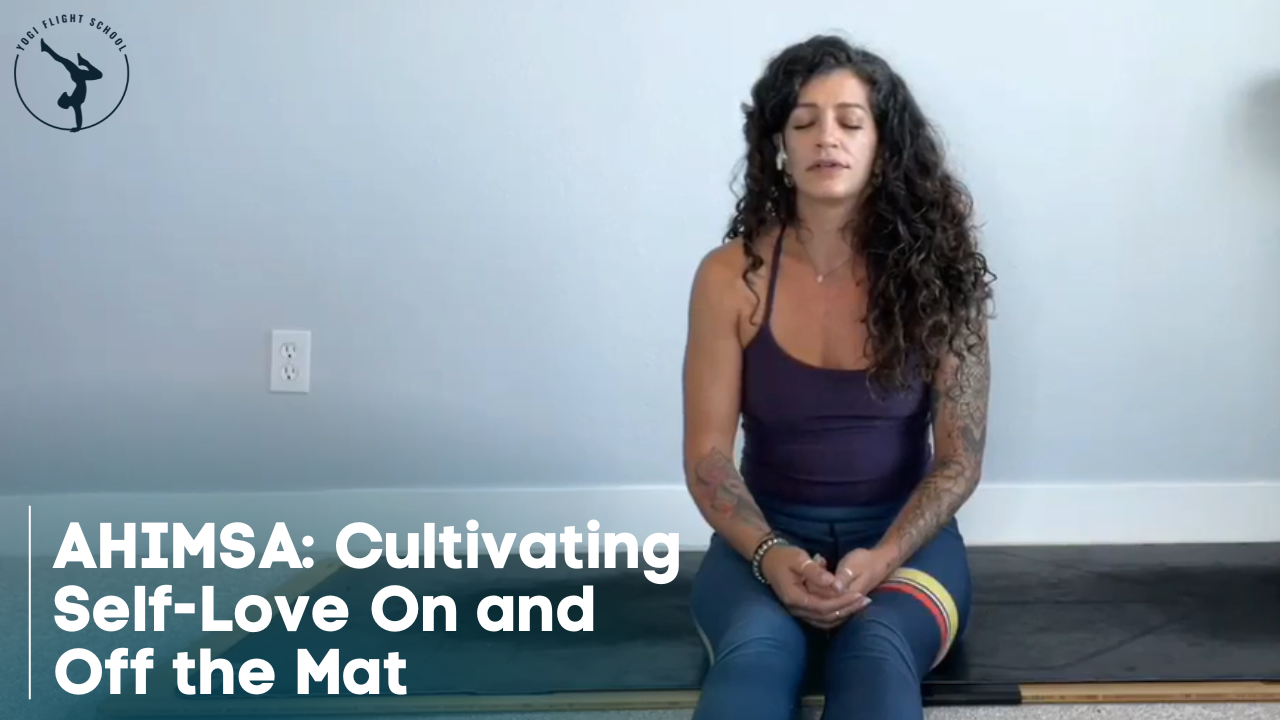AHIMSA: Cultivating Self-Love On and Off the Mat

How can we add love to everything we do, think, and say?
One of the foundational principles of yoga is the practice of AHIMSA, loosely translated as “non-violence.” It teaches us to embrace non-violence and compassion in every thought, word, and action.
Ahimsa is a concept that everyone can use during and beyond their yoga practice to gain a deeper understanding of the higher self.
Imagine you clocked out from a stressful or overwhelming day; body feeling heavy like lead and you know your mind is just about to turn off…but you decide to step on your mat for an intense yoga session to shake out all the negativity. They did say yoga can help reduce the effects of stress, even scientists approve! Right?
You push through those vigorous 60 to 90 minutes, ignoring the aches and pains. The next day you found yourself physically exhausted and emotionally drained. By ignoring the body’s signals to take it easier (or simply rest) you inadvertently practiced violence toward yourself - the opposite of Ahimsa.
But Ahimsa is not just about avoiding physical violence, it also reminds us to keep our mental and emotional well-being in mind. It reminds us that practicing non-violence involves treating ourselves with kindness, compassion, and self-acceptance both on and off the mat. Ahimsa is self-love.
Today we’ll take a deeper look into the concept of Ahimsa and how we can apply it to our practice and beyond. But first things first…
Understanding Ahimsa
Ahimsa, derived from the Sanskrit language, refers to "non-violence.” Its literal translation is "absence of injury."
It is the first principle from the Yamas in The Yoga Sutras of Patanjali. According to Patanjali, everything starts with Ahimsa – without embracing Ahimsa on and off the mat, everything else will not bear fruit.
The practice of Ahimsa means you are welcoming a state of mind that chooses compassion over harm and suffering toward yourself and all beings.
Ahimsa On the Mat
On the mat, Ahimsa involves honoring the body's limitations, respecting our boundaries, and avoiding forceful or aggressive movements.
This allows us to accept and be patient with ourselves by fostering a safe and nurturing environment for our physical practice.
When you forgo Ahimsa during your asana practice, your time on the mat would simply be a physical work-out and not a work-in.
The next time you step on your mat, remind yourself to:
• Not push yourself to doing poses that your body is not ready for yet;
• Let go of expectations about yourself and your practice;
• Be kind to yourself if you fall out of balance on your mat;
• Be patient with yourself if you don’t see as much progress as you’d like today; and
• Speak and think kind and loving words to yourself.
Ahimsa Off the Mat
Off the mat, Ahimsa encourages us to have more compassion for ourselves and others, and transform our relationships and interactions for the better by inviting mindfulness, empathy, and understanding in our hearts.
In our daily interactions, we can embrace Ahimsa by practicing conscious communication. We can choose words that uplift, inspire, and bring people closer together rather than words that hurt or create division.
Ahimsa can also mean becoming a mindful listener; we can foster understanding and empathy, nurturing connections with others.
The practice also reminds us to reexamine our relationship with the environment. It encourages us to adopt sustainable practices that can help give Mother Earth a chance to breathe better and connect more with nature.
As you go about your day, you can practice Ahimsa by:
• Being loving and kind to yourself and others through your thoughts, words, and actions;
• Practicing gratitude;
• Choosing an eco-friendly or vegetarian option; and
• Taking time to rest and restore your energy.
The Challenge
As you begin to incorporate Ahimsa into your life, challenges may start popping up and hold you back– it could be old habits, limiting beliefs, or self-criticism, judgment from our peers and society, or common social practices that conflict with non-violence.
However, remember that growth comes from a place of compassion and self-reflection.
Through Ahimsa, we learn to observe our thoughts and emotions, identify patterns that can cause harm, and give us the power to consciously choose alternative responses.
It may be difficult at times to practice this form of self-love; some days it’s a walk in the park, other days you feel like the Universe is testing you… but the peace that comes when you stick with it can be one of the best things you can experience on and off your mat.
Ahimsa is a powerful practice that can transform lives when we practice it on and off our mats.
As you go back into the world, I invite you to consider how you can integrate it into your daily life; start by cultivating self-compassion, honoring your own boundaries, and practicing conscious communication with loved ones.
Embrace Ahimsa today, and together, let us ignite the power of non-violence, creating a world where love, peace, and understanding prevail.

